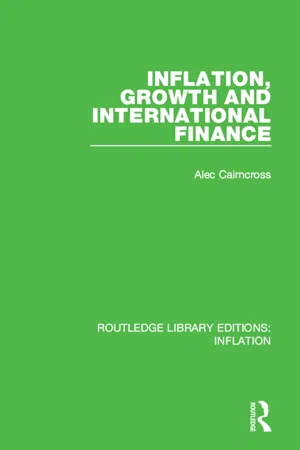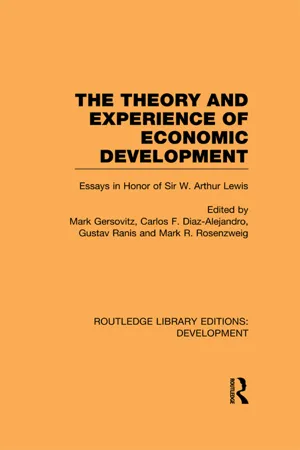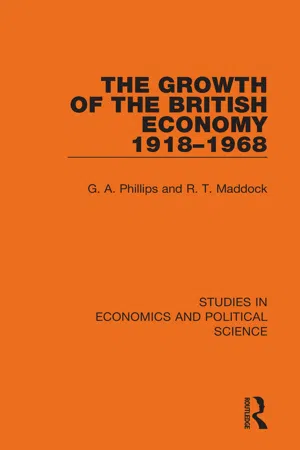History
UK Economic Growth History
The UK has experienced periods of economic growth and contraction throughout its history. Notable periods of growth include the Industrial Revolution in the 18th and 19th centuries, the post-World War II boom, and the expansion of the financial services sector in the late 20th century. Economic growth has been influenced by factors such as technological advancements, global trade, and government policies.
Written by Perlego with AI-assistance
Related key terms
Related key terms
1 of 4
Related key terms
1 of 3
5 Key excerpts on "UK Economic Growth History"
- eBook - ePub
- Alec Cairncross(Author)
- 2016(Publication Date)
- Routledge(Publisher)
3 Economic Growth in Britain1 DOI: 10.4324/9781315623801-31 Based on the thirteenth Hugh Macmillan Memorial Lecture delivered on 23 March, 1971 and reprinted from the Transactions of the Institute of Engineers and Shipbuilders in Scotland by kind permission of that Institution.It may seem natural—indeed inevitable—that economists should concern themselves with economic growth and development, a subject very much in everybody's mind since the Second World War. But if one looks back it is remarkable how little thought was given for well over a century to economic growth as opposed to such matters as tariffs, monopoly, taxation, imperialism, unemployment and financial crises. Economic growth was either taken for granted or submerged in more compelling issues such as tariff reform or trade depression. For a couple of generations before 1939 one hardly so much as heard the words ‘economic growth’; and the very concept of more or less continuous expansion of the economy seemed novel and paradoxical when there were still widespread fears of a post-war slump and a renewal of the chronic and seemingly interminable unemployment of the inter-war years. Yet the country has been advancing for nearly a generation at a rate never before experienced and complaining that it is not nearly fast enough and falls well below what other countries are achieving.In such a situation one might expect a flood of literature explaining why things have changed since before the war; why unemployment has been so consistently low and growth rates so consistently high all over the world; why the British record compares unfavourably with the record abroad; and what, if anything, can be done to accelerate economic growth in this country. There has, indeed, been a flood of literature; but some of it is not very readable and a great deal that is readable is superficial and unconvincing. I hesitate to add to the flood particularly as what I have to say may be thought to merit the epithets that I have just used. But I know of few subjects on which it would be more reasonable to turn to an economist for guidance or one better calculated to produce controversy and confusion in equal measure. Not that I aspire to settle the controversy or dispel the confusion. That is well beyond my powers. As with all major issues in economics it is only at election time that one is given simple and conclusive answers and as most of us learn in due course the answers then given become progressively less simple and less conclusive. - eBook - ePub
Study of Economic History
Collected Inaugural Lectures 1893-1970
- N.B. Harte(Author)
- 2012(Publication Date)
- Routledge(Publisher)
Tonight, I propose neither to bore you by discussing the details of my own research, nor to entertain you by belabouring my professional colleagues. Instead, I shall compromise by considering the subject of economic growth, and some of the general problems that economic historians encounter in dealing with it.II
Economic growth is essentially an economist’s concept: strictly speaking, it means a rise in real income per capita, or, in other words, a rise in average purchasing power per head of population, and it is obviously important because the welfare of any community is directly affected by the size and the trend of its output of goods and services. Needless to say, this is not everything: prosperity does not ensure happiness (though it surely helps); rapid economic growth may be accompanied by great economic, social, and political instability; and the distribution of wealth is almost as important as its size. Moreover, an undue preoccupation with economic growth can lead to a neglect of some aspects and periods of economic history and a distortion of others, even if we extend the mathematical range to include zero and negative growth and recognize that economic and social conditions interact upon each other. Yet whatever its dangers,2 the study of economic growth is a central theme in economic history, and I shall use it as a peg on which to hang some illustrations of the present condition of the subject and its current and prospective connections with economics and history. In what follows, for the sake of brevity, I shall speak of economic history rather than economic and social history; but at a later stage I shall comment on the relations between the social and economic aspects of the subject.In a sense, the economic historian’s dilemma is a by-product of current efforts to promote economic growth, both in advanced and so-called underdeveloped countries. It is often suggested that historians can shed light on the problems of the present by disclosing the secrets of the past, and as most of the underdeveloped countries are in a pre-industrial stage of development, and anxious to have an industrial revolution of their very own, an added stimulus has been given to the study of the first or ‘classic’ industrial revolution which occurred in eighteenth century England. This interest can, of course, be gratifying, even flattering to the scholar; but it has its disadvantages. Those who study history in the hope of relieving present discontents are apt to distort the past; and if the economic historian tries to provide answers to the questions posed by his academic colleagues, or by the general public, he immediately encounters serious difficulties—difficulties of communication, of method, and of substance—all of which stem from the endless subtlety and complexity of the process of economic and social change. Here, as elsewhere, as knowledge advances it becomes more precise and technical, more difficult to communicate to the layman; yet if the economic historian wishes to be heard he must be prepared to make simple straight forward statements about complex historical processes which he may not fully understand. This problem arises not only in addressing a popular audience but also in communicating with his indispensable academic colleagues, the economists and historians, though the difficulties are not the same in each case. It is his duty to warn the economists whenever they seem over-eager to apply the ‘lessons’ of the past to the problems of the present; but in order to command a respectful hearing the economic historian must not only acquire some command of the economists’ peculiar language, he may also be called on to make broad generalizations about the results of his researches in a way that troubles his historical conscience. His dealings with the historians, on the other hand, are less exacting, and they should be mutually beneficial provided that the economic historian displays a due regard to the limitations of his evidence, and an awareness of the dangers of a deterministic economic interpretation of history. The historians ought to sympathize with the economic historian’s desire to communicate, for the original meaning of the word history was: to inquire, to know, to tell what one has learned; but in approaching his fellow historians, the economic historian often senses that he must overcome certain barriers of scepticism, tradition, and indifference. Whenever this is so, he must restrain his impatience, remembering that he is a comparative newcomer to Clio’s circle, a dealer in parts rather than wholes; and he must recall J. H. Clapham’s well-known remark that while economic history is the most ‘fundamental’ type of history, it is not the most ‘important’, for ‘foundations exist to carry better things’.3 - eBook - ePub
The Theory and Experience of Economic Development
Essays in Honour of Sir Arthur Lewis
- Mark Gersovitz, Carlos F. Diaz-Alejandro, Gustav Ranis, Mark R. Rosenzweig(Authors)
- 2012(Publication Date)
- Routledge(Publisher)
LLOYD G. REYNOLDSEconomic growth is a national phenomenon. It occurs, or fails to occur, within the boundaries of a national state. Yet the existence and growth experience of other countries is highly relevant. After 1750 there was one country, the United Kingdom, and after about 1830 several countries, which had already embarked on a growth path which served to facilitate growth elsewhere. Since that time there has been a gradual diffusion of growth from leader to follower countries, which continues to the present day and has by now touched a large proportion, though by no means all, of the world’s population. This chapter explores some features of this process in the late nineteenth century.By growth we can mean either extensive growth, in which population and national product advance at about the same rate, or intensive growth, in which output pulls ahead and raises output per capita. While the latter is perhaps more interesting, the former should not be ignored. In the years since 1950, for example, most of the less developed countries have had population growth rates in the range of 2–3 percent, or even above this level in some Latin American countries. Simply to keep output rising at the same rate and to prevent deterioration of living standards is a substantial achievement.The first thing one observes in a potentially growing economy, such as the United Kingdom in 1750, France in 1800, or Japan in 1850, is a gradual upcreep of population. This is accompanied for quite a long time by a corresponding increase in output, by a pattern of extensive growth. By itself this increase in scale of the economy will facilitate division of labor, as Adam Smith reasoned, and will tend to raise output per worker. In follower countries one can count also on some diffusion of improved technology, and a further widening of markets through trade. - eBook - ePub
An Affluent Society?
Britain's Post-War 'Golden Age' Revisited
- Lawrence Black, Hugh Pemberton(Authors)
- 2017(Publication Date)
- Routledge(Publisher)
Economists and Economic Growth in Britain, c. 1955-65Roger Middleton*The role of economists1 in the rise to prominence of economic growth promotion as an explicit policy objective has recently been given a fillip by two emerging literatures which have deepened our understanding of what Hutchison called the developing ‘growth consciousness’ of this era.2 The first of these, which has been inspired inter alia by the literature on social learning and policy networks, concerns the so-called ‘Keynesian plus’ policies, namely the augmentation in the early 1960s of ‘classic’ short-term Keynesian demand management techniques and objectives for stabilization purposes with a range of supply-side initiatives directed at promoting higher growth.3 The second is much broader in scope, that is recent work - mostly part of, or inspired by, the ESRC’s Whitehall programme – into the underlying administrative and political failures of the various modernization programmes - of which Keynesian plus was a part - initiated in the post-Suez era of national re-evaluation and policy reorientation.4Both literatures have much broader ambitions than merely explaining the rise to prominence of the growth objective, but in both it is a constant preoccupation because of what we might call the big ‘what if question which is implicit (occasionally explicit) in the dominant ‘declinist’ historiography of post-war Britain:5 what was that counterfactual set of policies which, if introduced, and if resulting in higher growth (all other policy objectives also being simultaneously and satisfactorily attained), would have moderated relative economic decline, saved Keynesian social democracy from the traumas of the 1970s and thus made unnecessary the Thatcherite reaction against the so-called post-war consensus. In the following I take no position on most of those debates.6 My concern is only incidentally with specifying and defining this big ‘what if’; rather, it is more to do with ‘who’, the ‘why’ and the ‘how’: that is with the actors who generated the new growth consciousness and the mechanisms whereby it was diffused into the policy-making community, but above all with the effectiveness of those actors claiming economic expertise, the extent to which (in an operational and epistemological sense) their knowledge was useful and what culpability they might have for the eventual fate of that growth strategy which culminated with the Labour government’s National Plan, the life cycle of which was so aptly described by Opie, one of the academic economists who served briefly as an ‘irregular’ in the new Department of Economic Affairs (DEA), as ‘conceived October 1964, bom September 1965, died (possibly murdered) July 1966’.7 - eBook - ePub
- G. A. Phillips, R. T. Maddock(Authors)
- 2021(Publication Date)
- Routledge(Publisher)
The State and Economic GrowthThe Inter-war Period
Almost without exception, governments in advanced industrial countries have come to exercise, during the twentieth century, a steadily increasing influence on the growth of their economies. This influence is applied through a variety of policies, whose connection with growth may be direct or indirect, conscious or unconscious. In theory, indeed, any decision of government which alters the availability or allocation of resources may be said to have an effect on the rate of growth. Thus even nineteenth-century governments in Britain played some part in economic development, by interesting themselves, for example, in commercial relations with other countries, in the education and training of the labour force, and the maintenance of a stable currency. More deliberately, since 1914, the state has come to concern itself with such matters as the rate of investment, technical innovation, the distribution of income and wealth and the aggregate level of demand.Although it is true to say, therefore, that economic growth as such did not become an explicit aim of government policy in Britain until (at the earliest) 1945, long before then decisions of state had made a considerable impact on the development of the economy. It is thus both possible and necessary to analyse the importance of policy measures throughout the whole period since 1918. Moreover, even if the governments of the inter-war years lacked a conscious preoccupation with growth, they already clearly admitted a responsibility for the broader, more ill-defined subject of ‘welfare’. In practice this meant that whilst they continued to be inhibited in their activities by a prevailing economic orthodoxy which was hostile to state intervention, nevertheless they were confronted by certain social problems like mass unemployment which they felt an obligation to alleviate. The failures and omissions of the politicians of that generation to remedy unemployment are not termed so merely from hindsight. And it is obvious enough that had those governments devised policies adequate to deal with their acknowledged responsibilities, they would thereby have changed the rate of economic growth.
Index pages curate the most relevant extracts from our library of academic textbooks. They’ve been created using an in-house natural language model (NLM), each adding context and meaning to key research topics.
Explore more topic indexes
Explore more topic indexes
1 of 6
Explore more topic indexes
1 of 4




